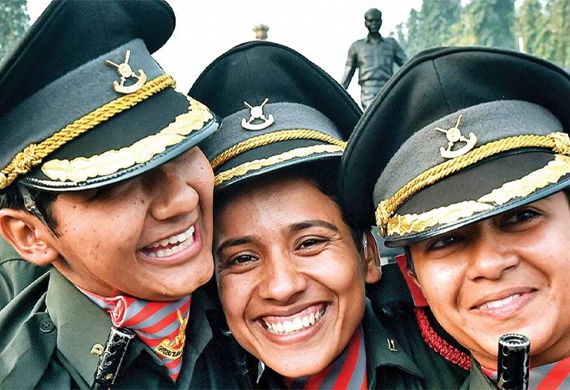
Navy Enhances Gender Inclusivity: Plans to Increase Women Cadets at NDA
By: WE Staff | Tuesday, 6 June 2023
In a notable move towards gender inclusivity and empowerment, the Indian Navy has proclaimed plans to increase the intake of women cadets at the prestigious National Defence Academy (NDA). Presently, the NDA is home to three women cadets, but the Navy has set its views on raising this number to 12, reflecting its commitment to fostering diversity and boosting prospects for women in the armed forces.
The first batch of women cadets, consisting of a total of 19 individuals with 10 for the Army, 6 for the Air Force, and 3 for the Navy, is assessed to graduate as part of the 148th course in May 2025. Although these exceptional women cadets, who sport crew cuts as a symbol of their dedication and commitment, were present during the passing out parade of the 144th course, they did not march on the parade ground. However, their existence marked a noteworthy landmark in the journey towards gender equality in the military.
The National Defence Academy has not yet finalized the exact intake numbers for women cadets. Yet, it is predicted that the digits will unhurriedly rise in the future years. The armed forces have taken commendable steps in inducting women into various arms and services, and the NDA aims to align with this progressive approach by providing equal opportunities for women cadets to pursue a career in the military.
The Navy, in particular, has been prescient in expanding the roles and commitments of women officers. Notably, women officers have been inducted as observers in the helicopter stream, enabling them to contribute effectively to crucial operations. Furthermore, the recent inclusion of the first woman pilot highlights the Navy's commitment to breaking barriers and embracing the potential of talented women in its ranks. Several women officers have also been deployed on the newly inducted aircraft carrier INS Vikrant, underscoring their invaluable contributions to the force's operational capabilities. The Navy recognizes the importance of highly trained women officers to meet its future operational requirements, thus emphasizing the need to increase the capacity for navy cadets at the esteemed NDA.
To promote inclusivity and create a level playing field, the NDA implemented a gender-neutral training methodology in June last year. This progressive approach ensures that boy and girl cadets undergo training together, fostering mutual respect, collaboration, and camaraderie. This holistic training environment helps in building strong and cohesive teams capable of meeting the challenges of the modern military landscape.
To facilitate the training and accommodation of women cadets, dedicated support staff and facilities have been established at the NDA. These specialized resources ensure that women cadets receive the necessary guidance, mentorship, and support to excel in their military training. The NDA has allocated a dedicated facility, refurbished with amenities tailored to their unique training requirements. Additionally, the NDA is actively pursuing infrastructure modifications to meet the gender-specific lifestyle needs effectively. Looking towards the future, the academy envisions the establishment of a separate squadron exclusively for girl cadets, further bolstering their empowerment and enabling them to thrive in their military careers.
The Indian Navy's initiative to raise the intake of women cadets at the National Defence Academy not only represents a significant step towards gender equality but also reflects the military's recognition of the massive talent and potential that women bring to the armed forces. By expanding opportunities, fostering inclusivity, and providing a supportive environment, the armed forces are creating a platform for women to excel and contribute meaningfully to the nation's defence. The progress made at the NDA is a testament to the collaborative action to empower women and construct a more diverse and inclusive military, capable of addressing the complex challenges of the 21st century.


.jpg)



